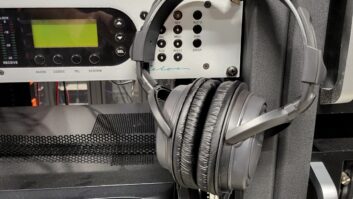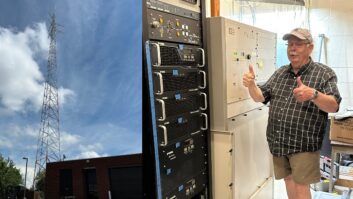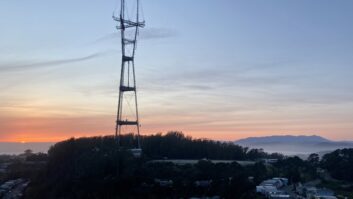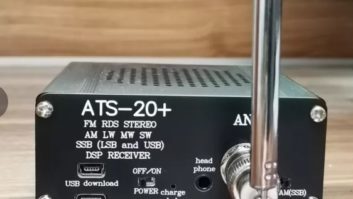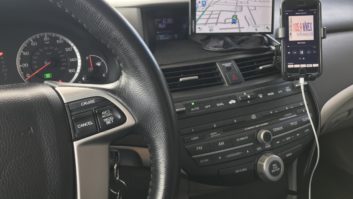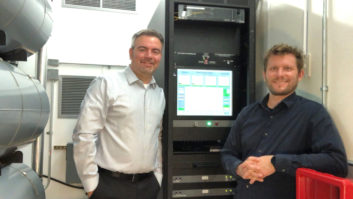One Becomes Two at WETA
Jan 1, 2014 7:55 AM, By William Harrison
How do you fit a square peg into a round hole? Well, OK, the peg isn’t actually square, it’s more of a rectangle. And the hole isn’t exactly round, it’s a three section wrap-around shape.

This was the case at WETA-FM in Arlington, VA. The air control studio had an 18-fader Studer OnAir 2000 console with audio running through it almost constantly for the last 14 years. There are only a handful of times when audio was not run from this room — when incredibly high winds threatened to break windows; two or three times for electrical work (new transformer, panel tighten down, etc); and a few times for emergency maintenance. Otherwise, it’s been a workhorse, getting audio to the transmitter 24 hours a day, 365 days a year. Thanks to a modular design and redundant power supplies, even maintenance was minimally intrusive to the day-to-day operations of the room. Some parts had been replaced through the years, like faders, screens, buttons, input modules and output modules, but others parts such as the main board had seen 14 years’ worth of electricity flowing through every capacitor, resistor, and integrated circuit. Intermittent errors and random audio dropouts combined with the fact that replacement parts are very difficult to find made replacing the console a simple decision.
Budgets are tight these days, and therefore options were extremely limited — as in, almost no budget. Fortunately we had one extremely over-equipped edit room containing a 16-fader Axia Element console and all the associated Axia nodes. An assessment of the equipment needed in air control, plus an inventory of available Axia equipment, equaled a quick decision to use an Axia system to replace the Studer.
One of the more expensive items in any buildout is the studio furniture, and this is where we had to get creative. In most cases, the furniture is built for the console, and WETA was no exception. The existing furniture was built for the Studer, which has three sections angled to one another so the operator sits at the center, and has faders wrap around to his left and right. The Axia Element, however, is a large rectangle. We could have just put the Element where the Studer had been, but in doing so would have made things awkward for the operator, and lost valuable counter space for keyboards, monitors, etc.
The solution? Build the console to fit the furniture. The Element was in a 24-position frame — four 4-fader modules, a monitor/navigation module, a production module, a SmartSwitch module, and a blank filler panel. Axia sells smaller frames that can be connected together, but budget prevented us from buying two smaller frames to rehouse the modules. So instead, we took the existing 24-position frame, covered it with blue painters tape, and had a machine shop cut it in half for about $100. This resulted in two 12-position frames, each missing an end panel. And as luck would have it, these two frames were just a bit smaller than each angled side of the Studer.

Before

After
As additional Element end panels were not readily available, an alternative needed to be found. Since the existing studio furniture uses hardwood edge trim, cherry end panels were custom made for all four ends of the consoles. These were drilled appropriately for screws, and coated in polyurethane.
With the console complete, the audio and GPIO nodes are ready to be installed. We chose a week for the conversion, except there was not a week to be had. Production schedules and deadlines were such that the conversion needed to take place over a single weekend, and the room needed to back on the air Monday morning.
– continued on page 2
One Becomes Two at WETA
Jan 1, 2014 7:55 AM, By William Harrison
With the nodes programmed and source profiles configured, we ordered cables — one color for audio, another for GPIO — in various lengths for connection to equipment. We also ordered adapters to go from RJ-45 to DB-9, DB-15, and DB-25 for control of equipment (alas, we could not find anything off the shelf to go from RJ-45 to DIN), as well as RJ-45 to screw terminal adapters for miscellaneous use. And finally, we ordered a handful of StudioHub adapters to connect any analog equipment, the reasoning being that soldering a single XLR to a network cable gives you a neat and tidy end product for AES, but having two XLRs hanging off twisted pairs just looks shoddy.

Before

After
When the weekend arrived, we switched audio and control to one of our production rooms, and double checked that everything was operational. Then we started removing equipment from air control, followed by cutting hundreds of cable ties, and removing nearly a mile of audio and control cable from air control, followed by removing the accumulated debris of 14 years. Bear in mind that each fader of a conventional console needs an audio and a control cable (some channels in the Studer needed six audio and six control cables). In air control, every cable went to a patch panel (including control cables) before going to the actual gear and the rest of the building. In the Axia realm, only a single cable goes to the console, carrying both power and data, so all those existing cables were eliminated. Those patch panels were eliminated as well, as you can configure the Element to allow any source to appear on any fader.
After some rearranging of equipment, we installed the nodes as well as a small fanless Cisco switch for the audio network. The gigabit uplink port of this switch goes to our main Cisco switch in the tech center, carrying all audio and data to and from the room to the rest of the facility, as opposed to the 24 AES cables that were in use previously. Next we pulled cables for audio and GPIO to each device as needed, including a few extras for future expansion. AES cables had XLR connecters soldered on; analog cables were given the appropriate StudioHub adapter, and GPIO cables used RJ-45 to whatever adapters as needed.
Finally, we brought in the console halves, put them in place, and connected them to the Element power supply. Upon power up, everything behaved as expected, and we were able to start finessing the details of the configuration. For this we brought in an on-air host who helped us decide the most efficient and useful fader positions for the most used audio sources. We also locked down a few faders so that only one source would ever be available to it (such as the control room microphone). Add in some cue speakers and a headphone amp (they had been built in to the Studer), and we had a functional studio up and running in very little time.
The primary goal of this rebuild was to eliminate audio problems caused by the Studer; however, we also took the time to simplify things. Gone are two of the four LCD screens in front of the host: weather radar, news service, automation system and utility computer. Instead, two larger screens were put in place for the automation system as well as the utility computer. The news service can be run on the utility computer, and since it is rarely used (we are a classical music station) the decision was made to eliminate the dedicated computer. The weather radar screen is now on the far wall of the room, being driven by a $35 Raspberry Pi computer — no Windows updates, no moving parts and easily replaced.
– continued on page 3
One Becomes Two at WETA
Jan 1, 2014 7:55 AM, By William Harrison

Before

After
As I write this, we are still making improvements to the room. The existing copy stand needs to be rebuilt to fit the new console, and the guest positions need to be rewired for use with Axia nodes for cough switches and headphones. But other than that, it is a fairly complete build, and has had very few issues since being put back on the air. Fortunately none of the issues have required any actual downtime of the console or the room.
In summary, I don’t think a project like this is possible without prior planning, having a backup plan, and the flexibility of an audio over IP system. Without all three of these, this would have taken much longer, and be much more complex.
Disecting a Console




Equipment List
Axia Audio Element, various Nodes
Benchmark HPA-1
BetaBrite Alpha
Burk ARC-16
Dell OptiPlex GX620
DynAudio Acoustics speakers
ESE analog clock
Gentner DH30
HHB CDR-830
Inovonics Model 510
Lilliput 10″ LCD Screen
Marantz PMD340
Middle Atlantic blank panels, rack shelves, vent panels
NAD 4300
Neumann TLM103, U87
O.C. White mic arms
Radio Design Labs ST-SH2
Raspberry Pi
Sony PCM-R500
Torpey digital clock
Windtech pop guard
Harrison is assistant chief engineer of WETA-FM, Washington, DC.
January 2014
FM antennas, WETA modifes a console, impedance demystified, AM service, studio furniture and more….






